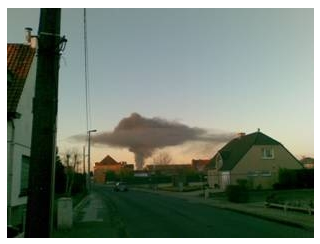When do smog episodes arise?
Smog is a contraction of the words 'smoke' and 'fog'. The word was first used in the 1950's, when on some winter days a fog of smoke hung over London. This smog was caused by the frequent use of (polluting) coal for domestic heating. The word smog is now used to indicate a period with too much air pollution. During summer, this is altered to 'ozone smog' or 'summer smog'. In winter periods, the main component of '(winter) smog' is particulate matter. Also in spring time (March/April), smog episodes can take place, mainly caused by particulate matter originating from an increase in inorganic, secondary particulate matter.
Smog episodes during winter (December-February) are mainly caused by limited dilution of air pollution, under unfavourable meteorlogical conditions: little wind (from continental directions) and a temperature inversion. Little wind results in very little horizontal dispersion (spread) of the pollution, while temperature inversions hinder vertical dispersion. When wind has an eastern component, polluted air from Eastern Europe is imported. This continental air is most often more polluted than Atlantic (maritime) air and can be transported over very large distances. Particulate matter from Eastern Europe can reach our country that way, leading to a significant increase of particulate matter concentrations.
Thermal or temperature inversion
Under normal circumstances temperature decreases as height increases. In case of a thermal or temperature inversion, the opposite is true: from a certain height temperature increases again and becomes higher than the temperature in lower layers. The air pollution, which is normally dilluted vertically, is now contained by this temperature inversion. The inversion layer acts as a kind of blanket that blocks air pollution. Thermal inversion often occurs during winter, when we are under the influence of a high pressure system, in which downward air currents are present. Descendig air heats up, which in physics is called adiabatic compression. If this is the case, we can speak of a subsidence-inversion.
If there also is little wind during a period of temperature inversion, the horizontal distribution of air pollution also gets tougher. The polluting compounds will accumulate in a smaller volume of air (because of the inversion), which will lead to an increase of, amongst others, particulate matter. The lower in the atmosphere the inversion begins, the smaller the volume in which the pollution can accumulate will be and thus the more unfavourable the inversion is for the air quality.

A temperature inversion can be visible sometimes: on the 18th of February 2008, a domestic fire occurred in Waregem (Flanders). Because there was no wind that day, the smoke plume rose vertically. Because there also was a temperature inversion, the smoke rose up to that level, after which it spread out horizontally. Photo by Frank Desoppere
